Cuban Missile Crisis – Two New Television Documentaries
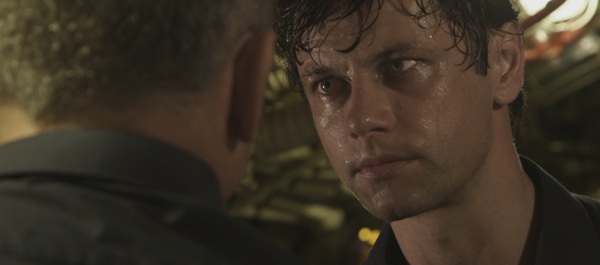
Re-enactment in Secrets of the Dead: The Man Who Saved the World of the tense moment aboard Soviet submarine B-59 when the hero refuses to give the captain permission to fire the nuclear missile. Courtesy Bedlam Productions
This year a number of milestones in military and political history are being commemorated in many ways, including with new television documentaries. It is the 150th anniversary of pivotal battles in the Civil War, as well as the birth of the Emancipation Proclamation. It has been 70 years since events in faraway places such as Midway, Guadalcanal and Stalingrad shaped the future direction of World War II and the world itself. And 50 years ago this month the world came as close as it ever has to nuclear annihilation.
{default}Fifty years ago the Cuban Missile Crisis tested the policy of mutual assured total destruction more than at any time before or since. That policy was the result of the escalation of nuclear armament by the Soviet Union and the United States that spawned the Cold War. And events in and around Cuba created the greatest test to date of that brinkmanship policy.
Two new documentaries to air this month on PBS approach aspects of the subject with completely different emphasis and style. "Cuban Missile Crisis – Three Men Go To War" is a one-hour special that premieres at 8 pm Eastern Time on Tuesday, October 23 (check local listings).
Immediately following this documentary is the second film, part of a long-running WNET series. Secrets of the Dead: "The Man Who Saved the World," premieres at 9 pm (check local listings).
Cuban Missile Crisis – Three Men Go To War
For those who are fifty-some years old and older, it isn’t too hard for them to remember where they were in the second part of October 1962. "Cuban Missile Crisis – Three Men Go To War" brings back memories of that time as if they were from yesterday’s news. Making use of the many audio and visual treasures from the time, the documentary carefully traces the storyline that centered on the three men, John F. Kennedy, Fidel Castro and Nikita Khrushchev. They could not have been any more different as individuals but without the efforts of at least two of them, we might not be here to enjoy these programs.
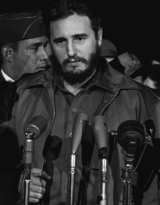 Castro, the commanding and clever idealist, was all the hard-line Soviet communists could ask for. Located so close to their number-one antagonist, in full control of his people, and with a message that was easy to spread to the region, they wanted to support and use him. A thousand miles to the north in Washington sat a popular president who could win over most people easily with his charm and wit. That would not work with Castro or Soviet Premiere Khrushchev, the dedicated party functionary with a flair for the dramatic.
Castro, the commanding and clever idealist, was all the hard-line Soviet communists could ask for. Located so close to their number-one antagonist, in full control of his people, and with a message that was easy to spread to the region, they wanted to support and use him. A thousand miles to the north in Washington sat a popular president who could win over most people easily with his charm and wit. That would not work with Castro or Soviet Premiere Khrushchev, the dedicated party functionary with a flair for the dramatic.
The political detent that existed in the world after World War II began to unravel when the U. S. discovered Soviet missiles in Cuba, aimed at America. The United States military, through NATO, had already placed conventional missiles aimed at the U.S.S.R. in member countries. Both sides had ample and sophisticated weapons to wipe each other out. The Cuban Missile Crisis was the match that could unleash that firestorm. All of the tension of the situation and pressure on those involved is recounted in this film through video and audio clips, words of the participants and a very interesting group of on-camera personalities. These are wonderful opportunities to hear from so many who lived through the experience and were close to the situation or to these three powerful leaders. Military men on both sides of the conflict, including Soviet officers who were in Cuba at the missile sites, offer unique perspectives. Sergei Khrushchev is always enlightening in talking about his father.
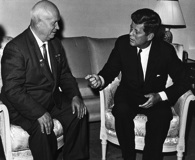 As I said before, the program brings back memories to older Americans. Fallout shelters, duck-and-cover exercises, United Nations speeches and President Kennedy on television are all vivid reminders of life in that era. But the program also has a rapidly paced smorgasbord of realistic and abstract visuals to appeal, I suppose, to the MTV generation. And some of this visual and musical imagery is reminiscent of what many consider the best cinematic story of the Cold War, Stanley Kubrick’s movie, Dr. Strangelove or: How I Learned to Stop Worrying and Love the Bomb (1964). That film, by the way, for all its satire has probably the best portrayal of what it was like to be part of America’s nuclear threat, the B-52 air fleet constantly hovering outside the borders of the Soviet Union packing powerful nuclear bombs.
As I said before, the program brings back memories to older Americans. Fallout shelters, duck-and-cover exercises, United Nations speeches and President Kennedy on television are all vivid reminders of life in that era. But the program also has a rapidly paced smorgasbord of realistic and abstract visuals to appeal, I suppose, to the MTV generation. And some of this visual and musical imagery is reminiscent of what many consider the best cinematic story of the Cold War, Stanley Kubrick’s movie, Dr. Strangelove or: How I Learned to Stop Worrying and Love the Bomb (1964). That film, by the way, for all its satire has probably the best portrayal of what it was like to be part of America’s nuclear threat, the B-52 air fleet constantly hovering outside the borders of the Soviet Union packing powerful nuclear bombs.
Whether or not the B-52s were on his mind, Khrushchev decided he was not going to oversee the end of the world. Lacking the help of a dedicated supporting cast, such as Kennedy had with his marvelous cabinet and military advisors, the Soviet premiere made the effort to negotiate a settlement to the crisis privately while spitting venom publically. It was all he could do. And ultimately Kennedy stood tall as the lone person on the other side who could make that deal work. Thanks to them, and those who were vigilant in their military and political roles in the crisis, we’re still here.
Secrets of the Dead: The Man Who Saved the World
Just when one might assume that diplomacy on the part of political giants averted nuclear annihilation comes the idea that four other men had the power to settle the thing themselves—almost. That is the thesis of Secrets of the Dead: "The Man Who Saved the World." While critical events were taking place on the globe’s surface, beneath the seas another drama was unfolding. Four Soviet conventional submarines (the Soviet nuclear subs were mothballed after the K-19 disaster, as the program mentions), were each carrying one very unconventional torpedo. The "special weapon" as it was known to the crew, was a torpedo with a nuclear warhead. And each sub’s captain had the power to fire it without orders from central command. This "doomsday" backup to the missiles in Cuba was a force heading to the island nation as the crisis unfolded above.
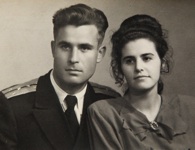 The documentary tells the story of the crew of B-59, one of the four submarines in this mission. On board B-59 was Vasili Arkhipov, the Brigade Chief of Staff of the four-sub mission. Of course there was some failsafe to the possibility of the captain of one of the subs arbitrarily starting a nuclear war. Each ship’s political officer had half the arming key. Given the reverence submarine crews had for their captains, that may not have been much of a deterrent. But Arkhipov had the final veto power.
The documentary tells the story of the crew of B-59, one of the four submarines in this mission. On board B-59 was Vasili Arkhipov, the Brigade Chief of Staff of the four-sub mission. Of course there was some failsafe to the possibility of the captain of one of the subs arbitrarily starting a nuclear war. Each ship’s political officer had half the arming key. Given the reverence submarine crews had for their captains, that may not have been much of a deterrent. But Arkhipov had the final veto power.
Utilizing a dramatic setting and actors for much of the program, Secrets of the Dead: "The Man Who Saved the World" has flashes that remind one of another Cold War motion picture, Seven Days in May (1964), as well as the great submarine drama The Hunt for Red October (1990). However, the really riveting substance comes from Ryurik Ketov, one of the submarine commanders on the mission (who still looks good in his uniform), U. S. Navy officers who were on the scene of the crisis and Arkhipov’s widow, who remembers very well the character of her husband and his demeanor leading up to the event.
When American ships discovered B-59 not far from Cuba in the South Atlantic and closed in to coax the submarine to the surface the captain, lacking direction from Moscow and not even knowing whether or not a war was in progress, wanted to launch the torpedo. It was Arkhipov who stopped him. Perhaps, as his widow remembers, it was because he saw what radiation could do to even a small group when he was a witness to the K-19 disaster; an event that eventually killed him prematurely.
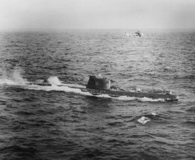 Secrets of the Dead: "The Man Who Saved the World" is more of a conventional television documentary but, like "Cuban Missile Crisis – Three Men Go To War," highly entertaining. There is naturally some overlap in the two programs, and minor production foibles in both that probably won’t bother most viewers. (But when that much is put into a production, why wouldn’t the creators want to get it all right?). I recommend seeing both programs to remember, or discover for the first time, how great individuals guided the world into a much less dangerous place, at least for a time.
Secrets of the Dead: "The Man Who Saved the World" is more of a conventional television documentary but, like "Cuban Missile Crisis – Three Men Go To War," highly entertaining. There is naturally some overlap in the two programs, and minor production foibles in both that probably won’t bother most viewers. (But when that much is put into a production, why wouldn’t the creators want to get it all right?). I recommend seeing both programs to remember, or discover for the first time, how great individuals guided the world into a much less dangerous place, at least for a time.
About the Author

Jay Wertz is the producer-director-writer of the award-winning 13-part documentary series Smithsonian’s Great Battles of the Civil War for The Learning Channel and Time-Life Video. He authored The Native American Experience and The Civil War Experience 1861-1865 and co-authored Smithsonian’s Great Battles and Battlefields of the Civil War with prominent historian Edwin C. Bearss. His most recent publications are War Stories D-Day: the Campaign Across France and War Stories: The Pacific, Vol. I, Pearl Harbor to Guadalcanal, published by Weider History Publications.


I saw this docu-whatever and it was FRIGHTENING!! Right now Obama is giving up our strategic advantages all over the world and getting nutin’ in return which will cost us dearly and soon!!
He just doesn’t understand the lessons( paid for in BLOOD!!!) of history which are as plain as the nose(EARS) on his face….
I only can pray we get to 2016 with out TOO much damage if we get there at ALL( IE Israel/ Hamas Syria Egypt Afghanistan CHINA N Korea the list is endless…….)